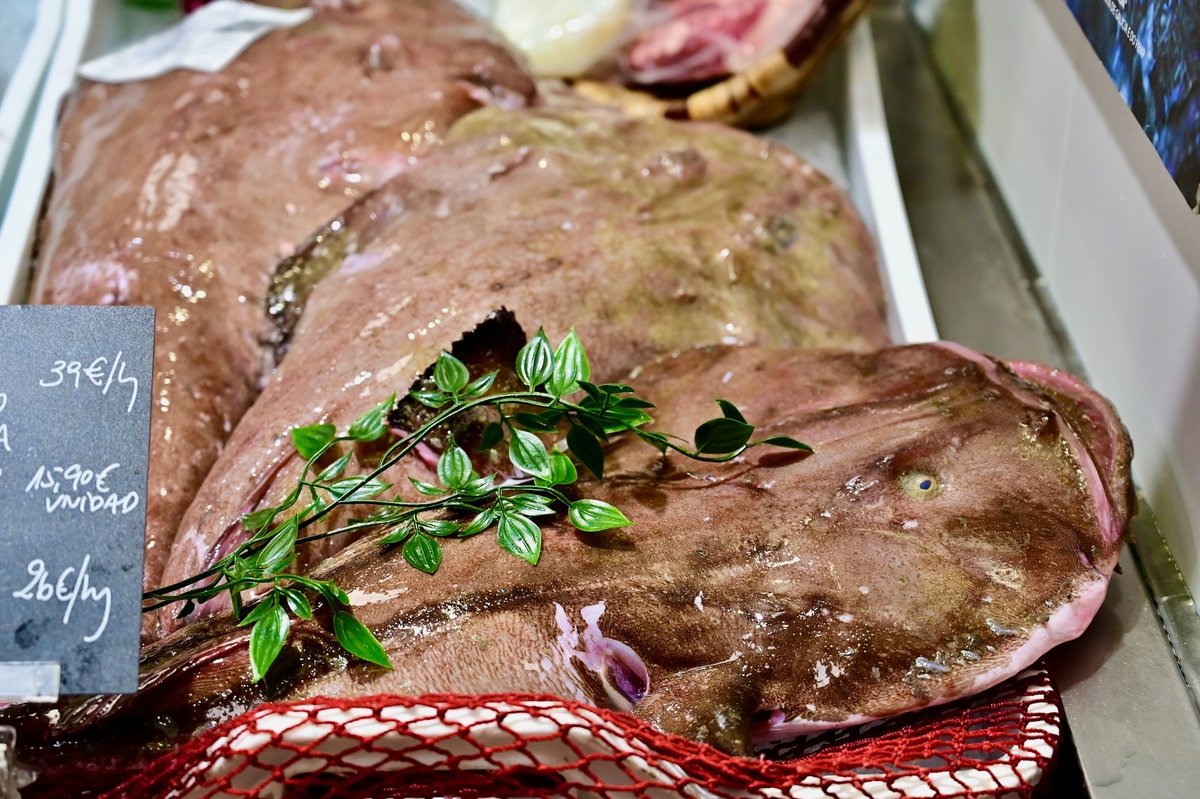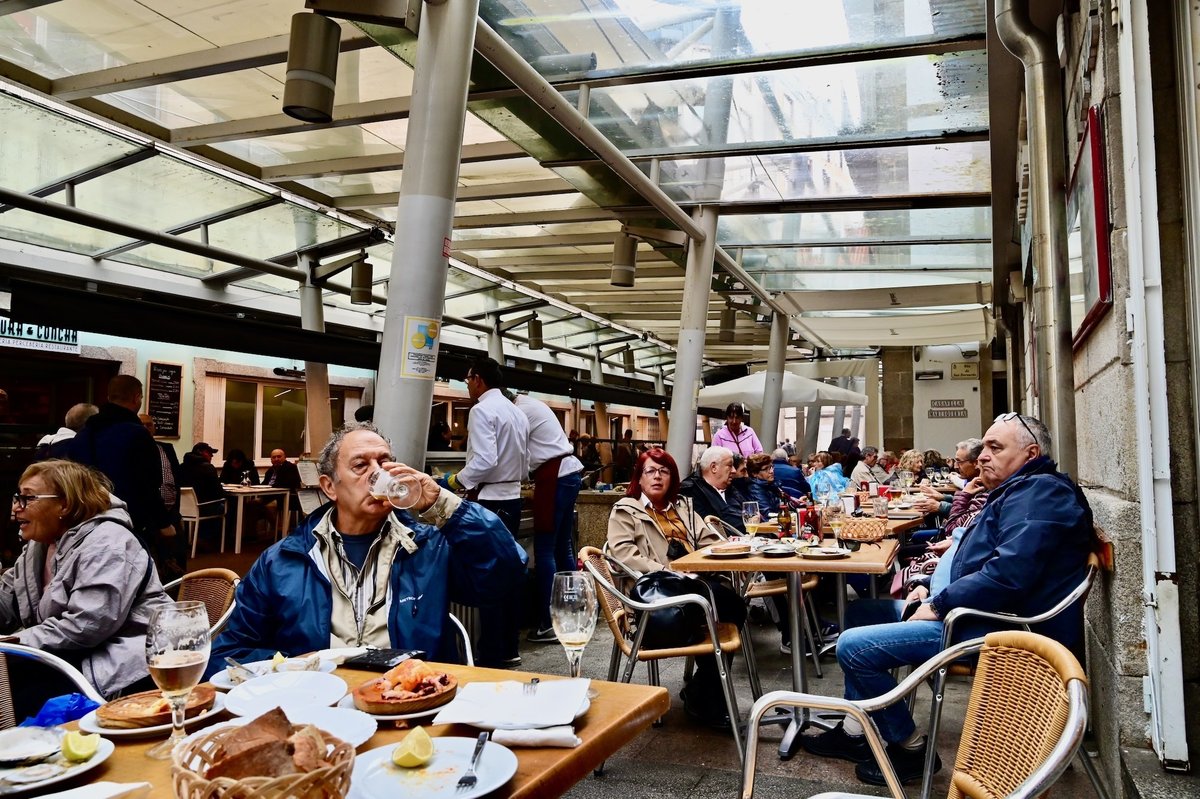
ガリシア2:魚屋通りの生牡蠣屋台
2022年10月に訪れたスペイン・ガリシア州で食べた美味いもの食い倒れ紀行です。第二回は魚屋通りに立つ生牡蠣屋台とマリスケリア。
English Follows Japanese
冬のビーゴ、街歩き
2022年10月24日月曜日、スペイン・ガリシア州最大の街ビーゴは朝から断続的な雨が続いていた。前週まで滞在していたポルトガル・リスボンがまだまだ秋の空気だったのに、ビーゴはすでに冬景色。まるで冬の日本海岸に来てしまったかのように、空も海も街も鈍いねずみ色だ。それでも前夜に食べた「蛸のガリシア風」をはじめ、美味い海鮮さえあればノープロブレム。日曜の夜のため閉まっていた「ルア・ペスカデリア(魚屋通り)」のマリスケリア(シーフード・レストラン)も月曜の昼時には開くはずだ。それまでしっかりお腹が空くように、午前中は街歩きと行こう。

港に面した宿から南へと坂道を登り、旧市街を突っ切って更に進むと、20分ほどでカストロ砦に着いた。ここは17世紀、スペイン王フェリペ4世の時代に建てられた要塞。古くからイギリス軍やポルトガル軍に攻め込まれていたビーゴの街を守るための戦略的な拠点とされた。現在は広い敷地を使った公園として市民の憩いの場に生まれ変わっている。
丘の頂上に向かって整備された石の階段ときれいに刈り込まれた緑の生垣が続き、階段 の上の高台には分厚い石造りの壁と角ばった稜堡を持つ、いかにも17世紀のヨーロッパらしい要塞が建っていた。だが、その石の壁一面が緑色の苔がむしているため、ヨーロッパの要塞というより、まるで日本や東南アジアの城のようにも見えてくる。「緑のスペイン」、ガリシアは湿潤な海洋性気候の土地なのだ。

ド・プログレソ市場の魚屋
カストロ砦のてっぺんからビーゴの街と湾の眺めを楽しんでいると、この日何度目かの雨がパラパラと降りだした。日本から折り畳み傘を持ってこなかったのが悔やまれる。買い物のため新市街方面へと向かうと、途中で小さな常設市場「ド・プログレソ市場」を見つけた。おお、どんな魚が売られているのだろう?!

ここは1909年にオープンした歴史ある市場だが、建物は近年になって改築され、一階部分が個人店舗が集まる市場とバール、地下は駐車場、2階がスーパーマーケットになっていた。早速一階の魚屋を覗こう! 入り口付近の八百屋や肉屋から奥に進むと、フロア奥の結構広いスペースが魚屋になっていて、氷を敷き詰めたステンレスの陳列台の上にその日の朝に採れた新鮮な魚介が並べられていた。

中でも一番目立っていたのは鮮やかな赤色をした体長35cmほどの大きなカサゴ。全身のトゲやヒレに赤地に黒の模様が入っていて、まるで「スターウォーズ・エピソード1」の悪役ダース・モールのような凶悪な見た目だ。これは煮ても焼いても間違いなく美味い魚だ!

続いて目立つのは大小様々な大きさのヒラメとカレイ類、いかにもリアス式海岸の海の底にへばりついていそうだ。ガリシアではどのようにして食べるのだろうか? 平たい魚といえば、隣の国ポルトガルでは雑炊やフリットにしていただくアンコウも、一尾丸ごとグロテスクな姿を晒していた。

そのほか、鯛や金目鯛、大きめのヒメジ、メジナ、鱈、ボラ、鯵に鯖、鰯、貝類はムール貝にマテ貝にザル貝に浅利、海老は赤海老に赤座海老、ブラックタイガーなどなど、店頭に並ぶ魚介どれもが色鮮やかに光り輝いている。これまで沢山の国の魚市場を周り、魚介を食べてきたが、普段から魚介を生で食べる習慣がある日本と比べると、多くの国では魚介を締める技術から、冷凍冷蔵の技術、輸送技術、店頭での保存技術までが一応に低く、目にして、そして、食べて失望することも少なくなかった。しかし、ガリシアの魚屋は全く日本の魚屋に負けていないように見える! 全ての種類の魚介を味見するためには最低でも一月くらいはキッチン付きの宿に滞在して料理しまくりたい! いや、この際、ここに住みたいくらいだ!

ド・プログレソ市場には魚屋のほかには、八百屋、チーズ屋、そして肉屋(長期熟成のステーキ塊肉まで揃えていた!しかも安い!)など、それぞれ魅力的な食材が並んでいるが、朝から歩き回っていたので、そろそろお腹が空いてきた。時刻は午前11時半、ルア・ペスカデリアのマリスケリアもそろそろ開き出す頃だ。さあ、先を急ごう!

生牡蠣屋台「Ostras Isabel」
正午前にルア・ペスカデリアに到着すると、通りの両側に並ぶマリスケリアが白いプラスティックのテーブルと椅子を通りに並べ、店を開き始めていた。と言ってもスペイン人は午後2時くらいに昼食を食べるので、この日は僕たちが一番乗りだ。
この通りの名物はマリスケリアの料理だけでなく、通りの真ん中の歩道部分に2軒並ぶ生牡蠣屋台である。屋台にはガラスの冷蔵ケースが置かれ、その場で生牡蠣を剥いてくれるのだ。買った生牡蠣は通りのマリスケリアに持ち込みが可能で、マリスケリアでは飲み物やその他の料理を頼む仕組みになっている。この日は2軒の屋台のうちの一軒「Ostras Isabel(イザベルの牡蠣)」だけが開いていた。名物女将のイザベルさんは不在だったが、いかにもベテランそうなコックコートにエプロン姿の中年男性が店頭に立っていた。6個で13€(当時のレートで1907円)の生牡蠣を頼み、すぐ横のマリスケリア「Bar Cocedero La Piedra(バール・コセデロ・ラ・ピエドラ)」に入った。



赤座海老や帆立貝のグリル
お店ではアルバリーニョ種の白ワイン一本と赤座海老(手長海老)グリル6尾、帆立貝グリル4個、そして前夜に続いて二度目となる獅子唐の素揚げ「パドロン」を頼んだ。

ワインで乾杯していると、すぐに屋台から生牡蠣が運ばれてきた。レモンを絞っていただきます! うん、小粒でミルキー、そして潮の味が濃厚で、冬の三陸海岸を思い出す味だ。美味すぎて、二人で6個は一瞬でペロリ。1ダース頼むべきだったかも?

続いてお店から、一尾100gほどの大きな赤座海老のグリルが運ばれてきた。甲羅の白とオレンジ色の模様がまるで錦鯉のような美しさ! こちらは食べやすいように、縦に半分に切り分けられている。レモンを絞り、長い海老を両手で持ち、頭の部分にかじりつくと、少々焦げた海老味噌が香ばしくも濃厚だ。そして身は火の通り具合が絶妙で、口の中に猛烈に甘さが残る。美味い! 美味すぎる! これまた6尾はあっという間に食べてしまった。僕は豪華なロブスターや伊勢海老よりも、スマートなのに濃厚な赤座海老のほうが好きなのだ。

獅子唐の素揚げ「パドロン」。この名前はガリシア中部の古都サンティアゴ・デ・コンポステーラの南にある同名の町の名前から取られ、地域呼称制度で守られている。日本の獅子唐よりもはるかに肉厚で、オリーブオイルで皮が焦げるほど素揚げにする。フレークソルトをたっぷりふりかけて食べると実に甘い。いくら食べても飽きない味で、ガリシアにいる間、ほぼ毎日食べることになった。日本に帰ってからも、東北地方で栽培されているパドロンを取り寄せて時々作っている。

最後に運ばれてきたのは中サイズの帆立貝のグリル。貝の内側が黒く、肝が鮮やかなオレンジ色、仕上げにパセリのみじん切りをふりかけてあるので、日本の同じ料理と比べると見た目はかなりカラフル。オリーブオイルと塩をふりかけて焼いただけだが、味が凝縮していて美味い。2人で4個では足りなかった! ガリシアでは何でも6個から頼むと良いようだ。

ワインのボトルが空く頃に、雨が大降りになり始めた。するとフランス人の巡礼客(巡礼については次回のサンティアゴ・デ・コンポステーラ編を参照)の団体が雨宿りのため通りに押し寄せ、お店が急に混み始めた。午後は特にやることはないが、一旦宿に戻って昼寝でもしようかな。

お店の会計を頼むと、先払いの生牡蠣を除いて、全部で59€(当時のレートで8,654円、2024年現在はインフレのため値上げしていると思われます)。西荻窪の居酒屋よりも安く、美味いシーフードとワインが楽しめるなんて。街自体には見るものは少ないかもしれないけれど、ビーゴ最高!
Galicia 2: The Raw Oyster Stands on Fishmongers' Street
Winter in Vigo, Exploring the City
On Monday, October 24, 2022, Vigo, the largest city in Galicia, Spain, was experiencing intermittent rain from the morning. While Lisbon, Portugal, where I had stayed the previous week, still had an autumn atmosphere, Vigo had already entered winter. The sky, the sea, and the city were all a dull gray, reminiscent of winter on the Japanese coast. But as long as I could enjoy delicious seafood like the "Pulpo a la Gallega" I had the previous night, there was no problem. The marisquerías (seafood restaurants) on "Rua Pescadería" (Fishmongers' Street), which were closed on Sunday night, should be open by Monday lunchtime. To work up a good appetite, I decided to take a walk around the city in the morning.

From the hotel facing the port, I walked south, climbing the hill, cutting through the old town, and continued further, reaching Castro Fortress in about 20 minutes. This fortress was built in the 17th century during the reign of King Philip IV of Spain. It served as a strategic point to protect the city of Vigo, which had long been invaded by the British and Portuguese armies. Today, it has been transformed into a park with a vast area, providing a place of relaxation for the citizens. A stone staircase, neatly trimmed green hedges, and a well-maintained pathway lead to the fortress at the top of the hill. The thick stone walls and angular bastions of the fortress, typical of 17th-century European architecture, stood proudly on the elevated platform. However, the entire stone wall was covered with green moss, making it look more like a castle in Japan or Southeast Asia. Galicia, known as "Green Spain," has a humid maritime climate.
The Fishmonger at Mercado do Progreso
While enjoying the view of Vigo and the bay from the top of Castro Fortress, it began to drizzle again for what felt like the umpteenth time that day. I regretted not bringing a folding umbrella from Japan. Heading towards the new town for some shopping, I stumbled upon a small permanent market called "Mercado do Progreso." I wondered what kind of fish they were selling here!
This historic market, which opened in 1909, had been recently renovated. The first floor housed individual shops and bars, the basement was a parking lot, and the second floor was a supermarket. Naturally, I went straight to check out the fishmongers on the first floor! As I walked past the greengrocers and butcher shops near the entrance, I found the fishmonger area occupying a fairly large space at the back of the floor. Fresh seafood caught that morning was displayed on stainless steel counters lined with ice.
The most striking sight was a large, bright red scorpionfish about 35 cm long. Its entire body, with spines and fins adorned in red and black patterns, looked as fierce as the villain Darth Maul from "Star Wars Episode I." This fish was sure to be delicious, whether boiled or grilled!
Next, the various sizes of flatfish and sole caught my eye, looking like they had just been clinging to the bottom of the rias. I wondered how they were prepared in Galicia. There was also a grotesque whole monkfish, often enjoyed as porridge or fritters in neighboring Portugal. Other offerings included sea bream, red snapper, larger goatfish, black seabream, cod, mullet, horse mackerel, mackerel, sardines, shellfish such as mussels, razor clams, cockles, and clams, as well as prawns including scarlet prawns, langoustines, and black tiger prawns. All the seafood on display gleamed vibrantly. Having visited many fish markets around the world and eaten plenty of seafood, I have often been disappointed by the poor quality of seafood in many countries compared to Japan, where seafood is commonly eaten raw. But this Galician fishmonger seemed to rival even the best in Japan! To taste all these types of seafood, I would need to stay in a place with a kitchen for at least a month and cook up a storm! No, at this point, I’d even consider living here!
In addition to the fishmonger, Mercado do Progreso also had greengrocers, cheesemongers, and butchers (even offering long-aged steak cuts at low prices!). But after walking around all morning, I was starting to get hungry. It was 11:30 AM, and the marisquerías on Rua Pescadería were probably starting to open. Let’s hurry!
Raw Oyster Stand "Ostras Isabel"
Arriving at Rua Pescadería just before noon, I saw that the marisquerías lining both sides of the street were setting up white plastic tables and chairs and beginning to open their doors. That said, since Spaniards typically have lunch around 2:00 PM, we were the first customers of the day. The specialty of this street is not only the food served at the marisquerías but also the raw oyster stands that line the sidewalk in the middle of the street. These stalls have glass refrigerated cases, and they shuck the oysters right there for you. You can bring the oysters you buy into the marisquerías, where you order drinks and other dishes. On this day, only one of the two stalls, "Ostras Isabel," was open. Although the famous proprietress Isabel was absent, a middle-aged man, who looked like an experienced chef in a cook's coat and apron, was tending the stall. I ordered six oysters for €13 (1,907 yen at the time), and we entered the nearby marisquería "Bar Cocedero La Piedra."
Grilled langoustines and Scallops
At the restaurant, we ordered a bottle of white wine made from the Albariño grape, six grilled langoustines, four grilled scallops, and, as a repeat from the previous night, a dish of deep-fried Padrón peppers. As we toasted with wine, the oysters from the stall were promptly brought over. We squeezed some lemon over them and dug in! They were small but milky, with a strong briny flavor that reminded me of winter on the Sanriku coast. They were so delicious that the two of us devoured all six in no time. Maybe we should have ordered a dozen?
Next, the restaurant served the grilled langoustines, each about 100 grams. The shell’s white and orange patterns were as beautiful as those of a Japanese koi fish! They were halved lengthwise for easy eating. I squeezed some lemon, grabbed the long prawn with both hands, and bit into the head, savoring the slightly charred, rich prawn miso. The flesh was perfectly cooked, leaving an intense sweetness in my mouth. Delicious! Too delicious! We quickly finished all six prawns. I actually prefer the lean yet flavorful scarlet prawns over the more luxurious lobster or spiny lobster.
The deep-fried Padrón peppers. This name is derived from the town of the same name, located south of the historic city of Santiago de Compostela in central Galicia, and is protected by a regional designation system. They are much meatier than Japanese shishito peppers, and are deep-fried until the skin is charred in olive oil. Generously sprinkled with flake salt, they taste incredibly sweet. I never got tired of eating them, and ended up having them almost every day during my stay in Galicia. Even after returning to Japan, I sometimes order Padrón peppers grown in the Tohoku region to recreate the dish.
Finally, the grilled scallops, medium in size, were served. The inside of the shell was black, the liver was a vibrant orange, and the dish was garnished with finely chopped parsley, making it much more colorful than a similar dish in Japan. Although they were simply grilled with olive oil and salt, the flavor was concentrated and delicious. Four scallops weren’t enough for the two of us! In Galicia, it seems that ordering in sets of six is the way to go.
As we finished the bottle of wine, the rain began to pour down heavily. A group of French pilgrims (for more on the pilgrimage, see the upcoming Santiago de Compostela chapter) suddenly crowded into the street to take shelter from the rain, and the restaurant quickly became busy. I didn’t have anything particular planned for the afternoon, so maybe I’ll head back to the hotel for a nap. When I asked for the bill, excluding the pre-paid oysters, the total came to €59 (8,654 yen at the time). I was amazed that I could enjoy such delicious seafood and wine for less than what I would pay at an izakaya in Nishi-Ogikubo. The city itself may not have much to see, but Vigo is the best!
